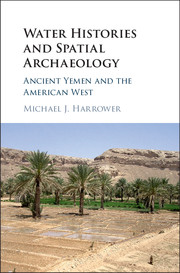
Water Histories and Spatial Archaeology: Ancient Yemen and the American West
Gerald Zarr
Michael J. Harrower.
2016, Cambridge UP, 978-1-10713-465-2, $116 hb.
The author of this technical study is an archeologist with experience in Yemen, and a leading specialist on Global Positioning System and Geographic Information Systems mapping. He uses those tools to compare the water histories of two arid regions, Southwest Arabia, c. 3500 BCE–600 CE, and the American West, c. 2000 BCE–1950 CE. He analyzes how the two areas—far removed from each other in time, culture and history—“are unique in similar ways,” emphasizing environmental, social, political and religious factors. This leads him into discourses on xenophobia, Orientalism, water crises, Western water law and even the War on Terror. Surprisingly, he does not discuss a living link between Yemen and the American West: acequias, the gravity-flow irrigation ditches that evolved over 10,000 years in the deserts of the Middle East. Carried to Spain by the Moors and thence to the New World, including the American Southwest, acequia technology endures in northern New Mexico and southern Colorado.
You may also be interested in...

Omani Author Zahran Alqasmi's Story About Life, Land and Honey
In his third novel, about a beekeeper living in Oman’s mountainous interior, local author Zahran Alqasmi grapples with a changing landscape around him.
Work Reveals Common Ground Across Massive Desert
The Sahara wasn’t always a desert. Around 9000 BCE it was a bucolic expanse where animals and lush vegetation thrived.
The Ebb and Flow of History on the Zambezi River
In tracing the past six centuries of history, historian Malyn Hewitt captures the cyclical rise and fall of the river and its people.